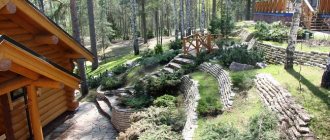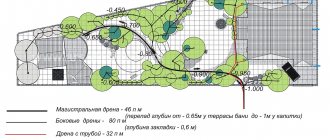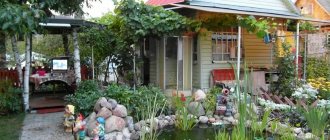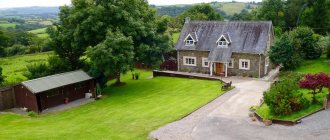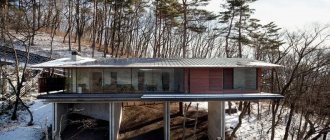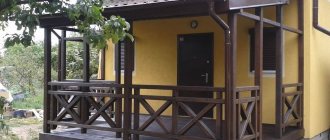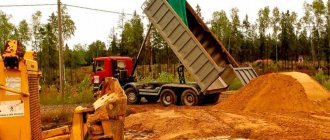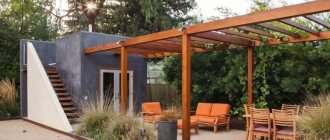Terracing in landscape design is a method of designing a site with a slope, with the help of which you can create several relatively wide steps (terraces) on it.
With terracing it is possible to:
- Creation of a simple drainage system to stop or prevent soil erosion.
- Design and zoning of the site.
- Using the slope area as efficiently as possible.
- Increasing the level of safety of movement around the site.
Landscape design studio "Kontur" carries out all types of landscaping and landscaping work in St. Petersburg and Leningrad. areas.
See price 2021 for more details HERE. Examples of our work - portfolio.
Areas with a slope, decorated using terracing, look very picturesque. However, this method has some important disadvantages:
- Requires a lot of money.
- Serious work on preliminary preparation of the territory is necessary: to determine the composition of the soil and the depth of groundwater.
- To care for plants on terraces, you will need to put in more effort due to the difficulties in organizing watering.
Before you begin planning work, you must first assess the steepness of the slope angle and its possible features. Thanks to this, it will be possible to avoid excessive costs for unnecessary structures. It is important to decide in advance what the terraces will be used for. If you plan to grow any plants on them, then it would be preferable to choose species that do not require frequent and abundant watering.
If you want to calculate the cost of a landscape design project, use our calculator.
BRIEF INFORMATION
LANDSCAPE ARCHITECT: Svetlana Chizhova, www.landy-art.ru FEATURES OF THE PLOT: height difference of about 4 meters GARDEN AREA: 30 acres CHARACTER: landscape, multi-level
Our customers purchased two neighboring plots of about 30 acres. A house, a garage and a bathhouse already stood on one of them; paving was done and retaining walls were built. Although the shape and workmanship of these elements were questionable, it was decided to keep them, since previous contractors had used a lot of reinforced concrete during construction. Breaking it up would be troublesome and expensive, but creating a new garden needed to be done economically and in a short time.
The second area was completely untouched and had birch trees and a few willows. The territory had a slope with a height difference of 4 meters. We decided to play with the relief beautifully and highlight several levels. Stairs and massive retaining walls were already built on the site. To soften their impressive appearance, they decided to build a rock garden. Sandstone 20–25 cm thick was used for masonry: the material is flat and pliable, making it easy for even non-professional masons to work with.
With the help of several walls at different levels, it was possible to create small cozy terraces. On each of them there were corners for relaxation, lawns, and ornamental plants were planted: perennial flowers, dwarf conifers, small spirea and barberries. There are many birch and other trees growing on the site. It is forbidden to change the soil level near trees, and it is strictly forbidden to fill up their root collars (with the exception of willows, they do not suffer from this), so we did a vertical layout, tied to the existing plantings.
The result is four levels, the differences between which are formed by gentle slopes and group planting. You can move from terrace to terrace using stairs or green slopes. One staircase turned out to be especially beautiful: three wide steps made of sandstone seem to be inscribed into the slope, and pyramidal thujas flaunt to the left and right.
What types of terraces are there and what are their differences?
Depending on the functional purpose of the planned terraces and the degree of slope slope, it is possible to use structures of various types:
- Stepped - for slopes with an angle of 8 to 12 degrees. Each step is usually made from 3 to 15 meters wide and reinforced with stone masonry.
- Trench - when the slope is more than 10 degrees. The top layer of soil is removed from the trench, and the bottom layer is used to construct shafts. After the shafts are formed, the bottom of the trench is filled with previously removed soil.
- Ridge - suitable for areas with a slope of 8 to 12 degrees. Ridges of soil from 30 to 50 centimeters high are poured across the slope.
- Ditch terraces are installed on slopes with a steepness of 35 to 40 degrees. They remove a layer of soil from storm ditches and form earthen ramparts. Each shaft should be two meters higher than the previous one.
Filling with plants
We deliberately did not make a circular route around the site and did not close the path. The paving is done near the house, it approaches the gazebo, pergola, and then you can walk along the lawn - as you move deeper into the garden, the landscape becomes more and more close to natural. This technique is often used on large areas. There are many flowering plants in the entrance area: peonies, mantles, salvias, thymes, phlox, catnip, heuchera, daylilies and others. They decorate the main path leading from the gate to the entrance to the house and frame the round lawn, creating a beautiful view from the living room windows.
Some plants were already growing here - we took them into account when drawing up the plan for the flower beds and transplanted them into new compositions. Flower beds also include woody plants: lilac, rock juniper Skyrocket, prickly spruce Glauca Globosa on a standard, hydrangea, mountain pine Mughus. The mixborder framing the lawn smoothly transitions into the edge of a small birch grove. The trees are planted with a lower tier of shade-tolerant shrubs: hazel, honeysuckle, dogwood, stephanandra and others. It is very interesting that real boletuses grow under the birches, and quite a lot! Shade-tolerant perennials feel good in openwork shade: hosta, brunnera, creeping tenacious, astilbe, bergenia, kupena, geranium.
There are now many fruit plants growing in the garden (apple trees, pears, cherries, plums, chokeberries, honeysuckle, currants, raspberries, gooseberries), and there is a vegetable garden in which vegetables, strawberries and herbs for tea are grown. The beds are made in such a way that the garden remains very neat and clean. They are raised above ground level using wooden barriers made of boards secured with stakes driven into the ground from the inside of the bed. Geotextiles are laid under the strawberry plantings, which protects the plantings from weeds, the soil from drying out and leaves the berries clean. Remontant varieties grow here, in which fruiting lasts all summer and even in autumn.
Trees and large shrubs grow along the perimeter of the site: Serbian spruce, Shaburovsky willow hybrids (Sverdlovskaya weeping, Sverdlovskaya sinuous, Shwerina improved, Memory of Bazhov), linden, Canadian serviceberry, Hungarian lilac, mock orange and others. They allow you to create a special microclimate - softer and warmer than outside the site. In addition, this arrangement of plants visually increases its area. Trees and shrubs are collected in groups. The space between them is mulched with crushed pine bark with a layer of about 10 cm. This makes it very easy to care for the garden, since the area between the plants remains clean and is not overgrown with weeds. This is also very useful for plants - moisture is retained under the mulch, the soil does not overheat on hot days. In three years, the planted plants have almost closed together, forming beautiful groups, while the mulch is practically invisible.
Stairs on the terrace area
When arranging a terraced garden, it is very important to take care of stairs with comfortable steps along which you can move to terraces of any level. The main staircase of a multi-level garden can be designed as part of a terrace complex or built separately from the overall structure. At the same time, the design of the staircase should be in harmony with the style of the terrace retaining walls and the entire estate. In addition to the main staircase, it is necessary to provide a system of additional paths. If the site is located on a very steep and high slope, it is worth thinking about arranging passages, equipping them with benches on which you can rest if you get tired from the climb. All elements of the staircase - railings, landings, as well as the edges of the paths can be decorated with green vines and weaving flowers. A variety of materials can be used to make stairs: wood and brick, natural stone and concrete slabs. The main thing is that the staircase is comfortable, safe and beautiful.
buildings
Opposite the terrace of the house there is a gazebo with a barbecue - a small summer kitchen where you can cook food in the fresh air during the warm season. The passage from the house is decorated with unusual paved squares that lead in the right direction, but at the same time tend to “escape” into the garden. An interesting children's playhouse has been made in the garden for the grandchildren of our customers, and lawns are used for active games. On a hot day, you can hide in the shade of trees or pergolas. In Italy they are built to protect from the hot sun. Of course, the climate in Moscow is completely different, but hot days in the summer are also quite common. The correct design involves placing the boards on the roof in an east-west direction - this way they will cast the maximum amount of shadow. It often happens that the boards “lead”: they dry out and spoil the shape. One trick will help you avoid this. Place them not one at a time, but three at a time, fastening them together. Such a rigid structure holds its shape well and prevents the boards from bending. The vines planted nearby will eventually cover the structure and provide shade and coolness. To protect the pergola from rain, transparent polycarbonate can be fixed on top.
Summer kitchen and dining area
There is a recess in the slope for the kitchen, so this area looks like a natural extension of the landscape. The kitchen is quite austere, but functional: there is a sink, a small work surface and a pizza oven. What more do you need for a family Italian feast in the backyard?
It is worth paying attention to the unusual teardrop-shaped table. This design move avoids the feeling of bulkiness. The whole project looks easy, dynamic, stylish.
An interesting detail is the mobile “roof” over the dining area. In order not to burden the space with complex architectural forms and to give the owners the opportunity to let the sun into the yard or, conversely, to hide from it, the designers proposed using thick fabric secured to three thick ropes instead of flooring.
This roof can be easily removed or washed if necessary.
Long lasting decorative effect
The garden is beautiful and interesting throughout the year and at any time of the day. For evening walks along the paths, garden lanterns with a height of about 1.2 m are installed; this is the optimal height for garden plots. The light source is below eye level and does not dazzle. In winter, such lamps are not covered with snow. In the gazebos and pergolas there are pendant lamps and sconces, the same ones are used to illuminate the entrances to the house, and the plants are illuminated from below. The plants are selected so that from spring to autumn you can observe the alternate flowering of various shrubs and flowering perennials.
Shrubs with colored foliage are used in the garden, and an autumn picture is thought out. Decoration of the garden in winter - coniferous plants and shrubs with colored bark (white turf - red, shoot turf - yellow, willow - orange).
The design and creation of this garden took place in 2012, from the next season it was professionally looked after by specialists from our company, so all the plants took root well, began to grow, and the garden acquired the appearance that was intended by the landscape architect. Our customers are satisfied with their garden and spend a lot of time here with the whole big friendly family consisting of three generations.
THANK YOU SVETLANA CHIZHOVA, ART DIRECTOR, FOR THE MATERIALS AND PHOTOS PROVIDED
Terraced garden lighting
The beauty of a terraced garden, especially in the evening, when twilight falls on the plants, will be emphasized and enhanced by well-executed, spectacular lighting. To equip it, you can use different types of lighting devices - both lamps powered by the mains, and lamps, night lights or spotlights powered by solar panels. You can successfully use both small night lights that indicate the location of garden paths, and spectacular lamps made in a modern style or imitating antique lamps and lanterns. It wouldn’t hurt to install floodlights equipped with motion sensors.
Solar garden pole lamp ERA 1.2W 155cm plastic black
Agricultural technology during the period of active root growth
Based on taking all this into account, subsequent agricultural technology is developed. In the first 3...4 years, while the plants are young and their root system is still rather weak, it is necessary to keep not only the row spacing, but also the row strips in a loose and clean state. For this purpose, the soil of row strips half a meter on both sides of the plants (total width - 1 m) is processed manually - in the fall by digging, in the spring and summer - by surface loosening. 3...4 years after planting, due to significant growth of roots towards the terrace fabric, there is no longer a need for this, and you can completely limit yourself to mechanized loosening of the rows. For this purpose, mounted disc harrows BDN-2.2, BDST-2.5, as well as cultivators are used. Fertilizers are also scattered only within the terrace fabric between the rows, where the bulk of the root system is concentrated. Row strips, as well as between terrace slopes, are covered with grass, but this is not dangerous - the bulk of the roots are in the treated terrace surface. The grass on the inter-terrace strips must be mowed.
Despite the low natural fertility of the excavation side of the terraces, cherry plants develop and bear fruit there no worse than on the outer side with its fertile soil. This is explained by the orientation of the root system towards the terrace fabric, as well as by the fact that soil moisture conditions on the excavated side of the terraces are somewhat better.
The described technology allows for more rational use of slopes that are inconvenient for agricultural land, and to obtain valuable products from them.
In gardens for personal use, terraces are made with a bulldozer or manually, and to fully utilize the area of the site, the slopes are made almost vertical, strengthening them with boards and stones. The soil on the terraces warms up faster, the plants bloom profusely and bear fruit better.
What to consider when choosing a location for a terrace
When planning an extension, it is important to choose the right location for it.
First of all, it must be sunny.
- The east and southeast are suitable for those who prefer to spend the morning hours on the terrace.
- The south side will be comfortable for sun lovers.
- The southwest and west are ideal for evening events.
Also, the location of the terrace depends on which room the exit will be from - the front entrance area, kitchen (dining room), living room.
It is important where it will go out. It is desirable that this be a cozy and picturesque corner of the garden, closed from prying eyes, creating the illusion of privacy.
Terrace overlooking the green area
